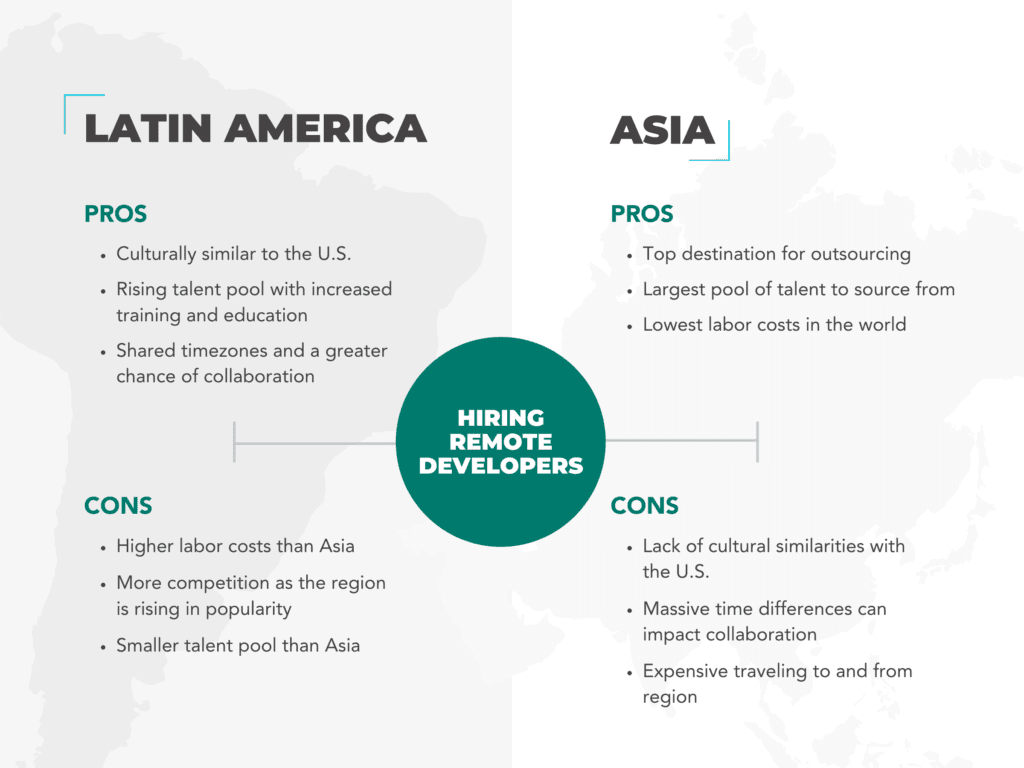
If you’re looking to grow your business and exceed the goals you’ve set for your team, it’s wise to think about the roles that will allow you to do so. For many companies, high-quality software developers are the answer. But the thought of finding the right developer (without breaking your budget) can be intimidating.
Luckily, regions like Latin America and Asia are hotspots for remote developers, with plenty of talent to pull from if you’re hoping to build your team. As the conflict in Ukraine is continuously changing, many companies are focusing their hiring efforts on these two different parts of the world. But what’s sets them apart from one another?
Though both have their fair share of talent, a handful of key differences separate developers located in Latin America and developers located in Asia. Read on to learn more about these regions and where you should be hiring remote developers.
Latin America
With almost 2 million software developers, Latin America has quickly become an outsourcing hotspot for companies looking to add high-quality talent to their teams.
Talent Pool
Latin America boasts an impressive one million tech graduates per year. Moreover, these governments continuously invest in technical education, laying the groundwork for a talented, growing group of software developers.
Popular countries include Mexico, Brazil, and Argentina, with countries like Colombia making their way into the conversation.
Language Barriers
One of the best things about hiring remote developers from Latin America is their proximity to North America and bilingual tendencies. Babbel notes that English is the third most spoken language in Latin America, with about 5.4 million speakers. As a result, fewer language barriers make it easier for companies to collaborate with outsourced developers, ensuring they’re on the same page for projects and responsibilities.
Talent Focus
Most Latin American countries focus on full-stack development, app development, and data science. With its high graduation rates, this region is continuously churning out educated developers with specialized skills.
Costs
If you’re a growing company, reducing hiring costs is both a short and long-term goal. Fortunately, cost-effectiveness is a key reason Latin America has become a hotspot for hiring remote developers. This is because the region has low labor costs overall, especially compared to the U.S.
Because salaries are low but talent is high, organizations can get more out of their hires without worrying about typical compensation costs that come with full-time, in-house employees.
Latin American developers are often paid between $25-$50 per hour.
Cultural Understanding
Due to its proximity to the U.S., many Latin American developers understand North American culture, with both regions sharing a handful of similarities. With strong work ethics, workplace hierarchies, and an emphasis on technology, Latin American developers make it easier for companies to find prospects who naturally fit in with their current team.
The time zone difference between Latin America and North America also averages less than two hours, making it easy for companies to hire developers who can work on a similar timeline. Traveling to and from Latin American destinations is also relatively easy, should your developer need to meet with you in person.
Asia
With more than 7 million IT graduates per year, Asia is a top choice for companies looking to hire remote developers while cutting costs.
Talent Pool
This region has a much larger number of developers than Latin America, Europe, and the U.S. In China alone, organizations will find a talent pool of over 7 million developers to choose from. Though initially known for outsourcing manufacturing and product development, there is now a sizable IT and software development market among China’s young and educated population.
Additional Asian countries are continuously adding to this talent pool, with India alone having an availability of more than 5 million developers. In addition, many Asian governments are investing sizable capital into tech infrastructure and education.
Language Barriers
Despite its distance from the U.S., many software developers in Asia speak English as their second language. With more than 300 million English speakers in Asia, many companies can find top talent without a complicated language barrier getting in their way.
However, similar to Latin America, it’s important to note that English may not be many developers’ first language, so a few hiccups here and there may be expected. Luckily, these language barriers are minimal and make it easy for organizations hiring remote developers to find the talent their team needs to grow.
Talent Focus
Many Asian countries focus on robotics, cybersecurity, data science, and DevOps, though most outsourcing is focused on low-level coding, IT management, and processing.
Costs
One of the best reasons companies have for hiring remote developers in Asia is the low costs associated with doing so. Asian developers are often paid $10-$25 an hour, significantly less than any other region.
For similar qualification levels, organizations have access to quality talent without exceeding their budget. Of course, there are other factors to consider, but companies looking to put savings first often opt for software developers in Asian countries.
Cultural Understanding
Unlike Latin American countries, due to their distance from the U.S. and the wide variety of cultures on one continent, hiring remote developers in Asia often comes with a handful of cultural barriers. And because of the vast cultural differences between the U.S. and Asian countries, there can be tension and misunderstandings when interfacing with outsourced teams.
Plus, certain Asian governments such as China can make some aspects of international partnerships difficult, so working with a trusted agency like CodersLink before hiring in this region is essential.
It’s also important to acknowledge the massive time difference between Asian countries and the U.S., making collaboration difficult and staying on the same timeline challenging. In addition, travel times to Asia from North America are also extensive, making it hard to meet in person when necessary.

Pros and Cons
There are pros and cons to both regions, all of which are important to consider as you consider hiring remote developers in Latin America and Asia.
Pros of hiring in Latin America:
- Culturally similar to the U.S.
- Rising talent pool with increased training and education
- Shared timezones and a greater chance of collaboration
Cons of hiring in Latin America:
- Higher labor costs than Asia
- More competition as the region is rising in popularity
- Smaller talent pool than Asia
Pros of hiring in Asia:
- Top destination for outsourcing
- Largest pool of talent to source from
- Lowest labor costs in the world
Cons of hiring in Asia:
- Lack of cultural similarities with the U.S.
- Massive time differences can impact collaboration
- Expensive traveling to and from region
Regardless of the region you choose, know that CodersLink is here to help. Through remote staffing and direct placements, we ensure the best companies find the best talent to continue growing their technology teams, fill skill-gaps and respond to scaling needs. Contact us to get started!


